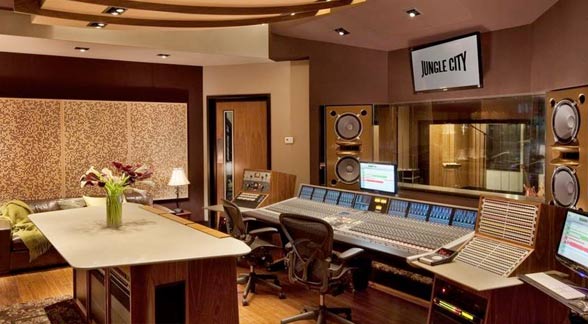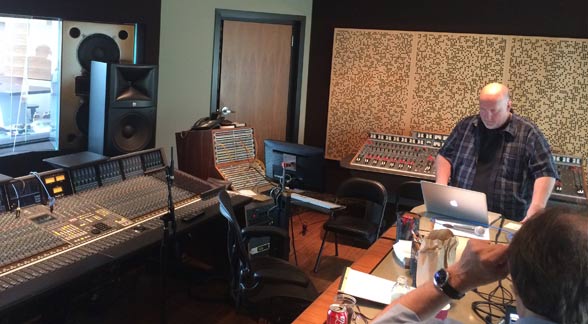Jungle Studios HRA Demo Sessions: Part II
The stated purpose of the event held at Jungle City Studios was to pump up awareness and knowledge about high-resolution music. The plan was to bring a number of audio engineer “top professionals” together and have them give a 20-minute presentation about their activities and passion for high-resolution music. The DEG, CEA, The Recording Academy and labels sold sponsorships to a few hardware vendors and some spots were made available to digital music retailers (only sites that have signed license agreements with the majors were invited…iTrax wasn’t even contacted) to help offset the cost of booking out the entire facility for the day. I was a late addition to the list of presenters because Elliot Scheiner ended up having a conflict and had to be dropped from the list.
The first presenter was Kevin Reeves of Universal Mastering and Sterling Sound. His recent work has been to do transfers of analog masters for distribution to sites like e-Onkyo in Japan and HDtracks. I wrote to Kevin and asked him to tell me what he played and the provenance of each track. He responded with the following information…I think this gives a very good insight into the engineering stages that various companies are requesting. Take a look:
1. Allman Brothers Band “Statesboro Blues” from the 1971 Show 4 at the Fillmore – 192/32. (16 trk masters were transferred in DSD128, then down converted to 192k/32bit PCM for mixing)
2. Oscar Peterson “It’s All Right With Me” from the 1959 master “Oscar Peterson Plays Cole Porter” – 192/32. (Original Verve master tape was transferred in DSD128, then DC’d to 192k/32bit for mastering)
3. Steely Dan “Bodhisattva”. This was a flat DSD128 transfer from the original master for our Blu-Ray friends in Japan. I DC’d it to 192/32 for the HRA playback.
4. Kiss “Strutter” from the first album. The original master tape was mastered in the analog domain and then converted to 192/24.
5. Stevie Wonder “Livin’ for The City” from the Innervisions master. Analog master was transferred flat to 192/24, and “mastered” digitally – although I hardly touched it, honestly. It sounded pretty spectacular on it’s own.
Kevin and I talked about what he does and what his clients expect when they license a selection of music. I found it interesting…the trend seems to be to leave more or less alone when it comes to crushing dynamics or other processing during the mastering stages. This is definitely a positive trend but wonder if it’s limited to transfers that are headed to “audiophile” sites. Seeing the number of tracks that have been transferred using DSD 128 is also trend that perplexes me. Why transfer to DSD 128 and then (down)convert to 192/32 bits? It would be better to transfer straight to 192/32-bits. Do a parallel transfers if you want…but don’t force me to accept the limitations of DSD.
Next up was Chuck Ainley, a multiple Grammy-winning engineer based in Nashville. He works a lot with country artists but I know him as the engineer for Mark Knoffler of Dire Straits. He played a number of selections, although I wasn’t in the room while he was presenting and he wasn’t at the sound check.
Between sessions, there were 10 minutes breaks. They set up the desserts and coffee on the 10th floor so entice people to head downstairs to the other vendor area. It was apparent early in the evening’s proceedings that things were falling behind schedule. Not really good news for the last presenter…me.
To be continued.



I would love to hear Strutter
PCM 96/24 and 192/24 are just storage and editing formats. Virtually all modern analog to digital converters are dealt to Sigma designs with 1 to 5 bits, and a 1-bit converter is inherently linear. Looking at an 88.2/24 file, you can’t really tell whether it was generated by a 5-bit converter operating at 2.8 MHz or a 1-bit converter operating at 5.6 MHz — the high-frequency noise is gone in either case. So, what exactly is your objection to transferring analog tapes or making recordings in DSD128?
Among the problems associated with DSD at any rate is the generation of ultrasonic noise due to the 1-bit encoding technique. I don’t follow you when you assert that the “high-frequency noise is gone”…it’s there in the spectra that I look at from actual downloaded files. The second reason is that there is not way to work with DSD in a production environment…that’s why DXD and high-sample rate PCM are used. A simple transfer to DSD from an analog tape is the best case…but rarely are simple transfers enough.
Every Delta Sigma converter — which means almost every converter on the market — uses noise shaping. The noises filtered before decimation. The noise from DSD128 doesn’t rise until past 40 kHz — see http://www.lindberg.no/english/collection/004.pdf
It’s just a question of whether you want the filtering and decimation done within the chip or in postprocessing on the computer.
The article you referenced is all about why DXD is necessary to work in DSD. ANd DXD is actually high sample rate PCM…so what’s the point of using DSD at all?
OK, I’ll bite: what did Kevin say when you asked him why he first converted to DSD128 and then to PCM 192k/32? If you didn’t ask or he didn’t answer candidly because of limited time, I hope he’ll give you the time of day after this event to answer that candidly. Technically, it seems unnecessary at best and most likely adds problems easily avoidable by simplifying things to just go straight to PCM 192k/32.
So that leaves commercial reasons. Just shot-in-the-dark guesses: a firm funded Sterling’s tape transfer equipment or software only if tapes were first transferred to DSD, or Sterling has outsourced the actual tape transfer to a firm that either only does DSD transfers or provides a price break for those.
I will ask Kevin. In fact, I’m going to reach out to all of the participants that participated in the event on Tuesday evening and ask them to do an online interview. My guess…without having any clue as to the merit of my guess…is that the transfers are done in Japan by another team and then mastered by Kevin. He gets the DSD 128 transfers and has to convert them to high sample rate PCM to work on them The clients would be much better served to avoid the DSD stage and head straight to 192/24 bit PCM.
” Why transfer to DSD 128 and then (down)convert to 192/32 bits?”
I recall some articles that thought DSD was preferable for long-term archiving of analog masters or analog multitrack masters. I can’t remember the exact reasoning…. but perhaps this line of thought has established a foothold in the profession.
The only valid use of DSD at any rate is for the archiving of older analog tapes OR the recording of a live concert event that won’t require any additional production work. And the archiving use was only applicable back when CD standard PCM was the norm…now that we have great quality high definition PCM the use of DSD is pointless.